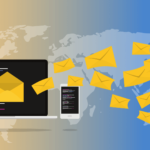Working from home has become increasingly popular in recent years, and even more so in the wake of the COVID-19 pandemic. While there are many benefits to working from home, such as increased flexibility and reduced commuting time, it also comes with its own set of challenges. One of the biggest challenges is avoiding distractions, which can significantly impact productivity. In this post, we will discuss tips on how to avoid distractions when working from home.
Key Takeaways
Throughout this blog post, we’ve explored various techniques to avoid distractions when working from home:
- Creating a Dedicated Workspace: Establish a designated area for work to signal the start of your productive time.
- Minimizing Environmental Distractions: Manage noise and interruptions from your surroundings to maintain concentration.
- Establishing a Productive Routine: Define work hours, develop morning rituals, and take regular breaks to stay focused.
- Limiting Digital Distractions: Manage notifications and block access to non-essential websites during work hours.
- Prioritizing Tasks and Staying Organized: Use to-do lists and set clear goals to streamline your workflow.
- Staying Accountable and Disciplined: Share your schedule with others and avoid procrastination to meet deadlines.
- Maintaining Work-Life Balance: Sign off at the end of the day and engage in physical activity to recharge and stay healthy.
1. Set Up Your Workspace

Working from home offers the flexibility of choosing your workspace, but it’s crucial to create an environment that fosters productivity and minimizes distractions. An organized and well-designed workspace can significantly impact your ability to stay focused and efficient throughout the workday.
Create a Dedicated Workspace
When you work from home, it’s essential to have a dedicated area solely for work-related activities. This space should be separate from where you relax or engage in leisure activities. Having a designated workspace signals to your brain that it’s time to be productive, making it easier to get into the right mindset for work.
Tips for Setting Up Your Dedicated Workspace:
- Choose the Right Location: Pick a quiet area in your home with minimal foot traffic and distractions. Ideally, find a spot with natural light to improve your mood and energy levels.
- Invest in Ergonomic Furniture: Ensure your desk and chair are ergonomically designed to promote good posture and prevent discomfort during extended periods of work.
- Personalize Your Space: Add elements that inspire and motivate you, such as plants, artwork, or meaningful quotes. A personalized workspace can make you feel more connected and engaged with your work.
L-Shaped Home Office Wood Corner Desk
Sytas Ergonomic Mesh Office Chair
Minimize Environmental Distractions
Working from home often means dealing with environmental distractions that are uncommon in a traditional office setting. Addressing these distractions proactively can help you maintain focus and concentration.
Dealing with Environmental Distractions:
- Manage Noise: If you share your living space with family members, roommates, or pets, consider using noise-canceling headphones to block out ambient sounds. Alternatively, use background white noise or soothing music to create a more conducive work environment.
- Communicate Boundaries: Let others in your home know your work hours and the importance of minimizing interruptions during those times. Set clear boundaries to avoid unnecessary distractions.
- Keep it Tidy: A cluttered workspace can lead to a cluttered mind. Regularly declutter and organize your workspace to create a sense of order and reduce distractions.
By establishing a dedicated workspace and minimizing environmental distractions, you can create a more focused and productive atmosphere while working from home. Remember that everyone’s ideal workspace may differ, so experiment with different setups until you find what works best for you. A well-designed workspace can make a significant difference in your remote work experience and overall job satisfaction.
2. Establish a Productive Routine

A well-defined routine can be a powerful tool to maintain focus and productivity while working from home. By establishing a consistent daily schedule, you can create a sense of structure and purpose, making it easier to stay on track with your tasks.
Define Your Work Hours
Setting clear work hours is crucial when working remotely. It helps you and others in your household understand when you’re available for work-related responsibilities.
Tips for Defining Your Work Hours:
- Consistency is key: Try to start and finish work at the same time each day to establish a routine.
- Communicate with others: Make sure your family members, roommates, or anyone sharing your living space knows your work schedule to minimize interruptions.
- Use technology: software like schedulers and email automation can help when there just are not enough hours in the day.
Morning Rituals
The way you start your day can significantly impact your productivity and focus. Establishing a morning routine can help you transition from a relaxed state to a more focused work mindset.
Ideas for Morning Rituals:
- Avoid Checking Devices Immediately: Resist the urge to check your emails or messages as soon as you wake up. Give yourself some time to ease into the day without distractions.
- Exercise or Meditate: Engage in light exercise or meditation to clear your mind and boost your energy for the day ahead.
Take Regular Breaks
Taking short breaks throughout the day can help prevent burnout and maintain your concentration during work hours.
Tips for Incorporating Breaks into Your Routine:
- Use the Pomodoro Technique: Work for a set period, like 25 minutes, then take a short 5-minute break. After four sessions, take a more extended break.
- Move Around: Stretch or take a brief walk during breaks to refresh your mind and reduce physical strain.
By establishing a productive routine, you can set the tone for a focused and efficient workday. Remember that finding the right balance between work and personal time is essential to maintaining your well-being and productivity while working from home.
3. Limit Digital Distractions – How to avoid distractions when working from home

In the digital age, staying connected is easier than ever, but it also opens the door to numerous distractions. Managing digital distractions is essential for maintaining focus and productivity during remote work.
Manage Your Notifications
Constant notifications from emails, social media, and messaging apps can interrupt your workflow and reduce productivity.
Tips for Managing Notifications:
- Prioritize Notifications: Disable non-essential notifications on your computer and smartphone, allowing only work-related or urgent messages to come through.
- Set Specific Times: Schedule specific intervals throughout the day to check emails and messages rather than being constantly interrupted.
Block Social Media and Entertainment Sites
Social media platforms and entertainment websites can be a significant source of distraction. Limiting access during work hours can help you stay on track.
Methods to Block Distractions:
- Website Blockers: Use browser extensions or apps that block access to specific websites during designated work hours.
- Create Separate Accounts: If possible, consider creating separate accounts for work and personal use, allowing you to maintain a clear boundary between the two.
By managing your digital environment and minimizing distractions from online platforms, you can significantly improve your focus and productivity while working from home.
4. Prioritize Tasks and Stay Organized

When working remotely, it’s essential to stay organized and prioritize tasks effectively to make the most of your time and energy.
Create To-Do Lists
To-do lists are a simple yet powerful tool for keeping track of your tasks and ensuring nothing falls through the cracks.
Tips for Creating Effective To-Do Lists:
- Break Down Tasks: Divide larger projects into smaller, manageable tasks to make them less overwhelming.
- Use Task Management Tools: Consider using digital task management apps or tools to keep your to-do lists organized and easily accessible.
Set Clear Goals
Setting clear goals for each day or week can give your work more direction and purpose, helping you maintain focus and motivation.
Tips for Setting Goals:
- SMART Goals: Make sure your goals are Specific, Measurable, Achievable, Relevant, and Time-bound.
- Focus on Priorities: Identify the most important tasks and prioritize them to tackle first.
By staying organized with to-do lists and setting clear goals, you can streamline your workflow and reduce distractions that come from feeling overwhelmed or unsure about what to do next.
5. Stay Accountable and Disciplined

Working from home requires self-discipline and accountability to stay focused and meet your work responsibilities.
Share Your Schedule
Communicating your work schedule to those sharing your living space can help them understand when you need to be undisturbed.
Tips for Sharing Your Schedule:
- Family Meeting: Have a family or household meeting to discuss your work hours and the importance of minimizing interruptions during those times.
- Visual Cues: Consider using a visual indicator like a “Do Not Disturb” sign outside your workspace when you need uninterrupted focus.
Avoid Procrastination
Procrastination can be a major productivity killer when working from home.
Strategies to Avoid Procrastination:
- Set Deadlines: Establish realistic deadlines for tasks and hold yourself accountable to meet them.
- Reward System: Create a reward system for completing tasks on time or achieving milestones to motivate yourself.
By staying accountable and disciplined, you can create an environment that supports productivity and minimizes distractions while working from home.
6. Maintain Work-Life Balance

Maintaining a healthy work-life balance is crucial when you work from home to avoid burnout and ensure overall well-being.
Sign off at the End of the Day
One of the challenges of working remotely is the blurred boundary between work and personal life. It’s essential to disconnect from work at the end of the day to recharge and enjoy your personal time fully.
Tips for Signing Off:
- Set a Clear End Time: Establish a specific time each day to finish work, and stick to it.
- Create a Shutdown Routine: Develop a routine that signals the end of the workday, such as turning off your computer, closing your workspace, or engaging in a brief relaxation activity.
Engage in Physical Activity
Regular physical activity is not only beneficial for your health but also helps improve focus and concentration.
Ways to Incorporate Physical Activity:
- Take Short Breaks for Exercise: Use your breaks to stretch, do a quick workout, or take a walk outside.
- Schedule Regular Exercise Sessions: Block out time in your schedule for more extended exercise sessions, such as yoga, jogging, or home workouts.
By maintaining a healthy work-life balance and incorporating physical activity into your daily routine, you can enhance your overall well-being and productivity while working from home.
Working from home offers numerous benefits, including flexibility and comfort, but it also comes with its share of distractions. By implementing the right strategies and maintaining discipline, you can significantly improve your focus and productivity while working remotely.
By implementing these strategies and customizing them to fit your unique work style and preferences, you can create a more productive and fulfilling work-from-home experience.
Remember, finding the right balance between work and personal life is crucial for long-term success. Be patient with yourself as you adapt to remote work, and don’t hesitate to experiment with different techniques until you find what works best for you.
Here’s to a successful and distraction-free remote work journey! Happy working from home!
FAQ
What are some common challenges of working from home?
Distractions. It can be difficult to stay focused when there are so many distractions at home.
Loneliness. Working from home can be isolating, especially if you don’t have a lot of contact with other people during the day.
Self-discipline. It can be difficult to stay motivated and on track when you’re not in a traditional office setting.
Technology problems. If your internet goes down or your computer crashes, it can be difficult to get your work done.
What is the importance of setting up a dedicated workspace when working from home?
Setting up a dedicated workspace when working from home is crucial for productivity. It signals to the brain that it’s time to be productive, making it easier to get into the right mindset for work. This space should be separate from relaxation or leisure areas.
How can one manage environmental distractions at home?
Managing environmental distractions involves addressing noises and interruptions. If living with family members, roommates, or pets, consider using noise-canceling headphones or background white noise. It’s also essential to communicate work hours and boundaries to others in the household.
How can digital distractions be minimized during remote work?
To minimize digital distractions, prioritize notifications by disabling non-essential ones and scheduling specific times to check emails and messages. Additionally, consider using website blockers or creating separate accounts for work and personal use.








